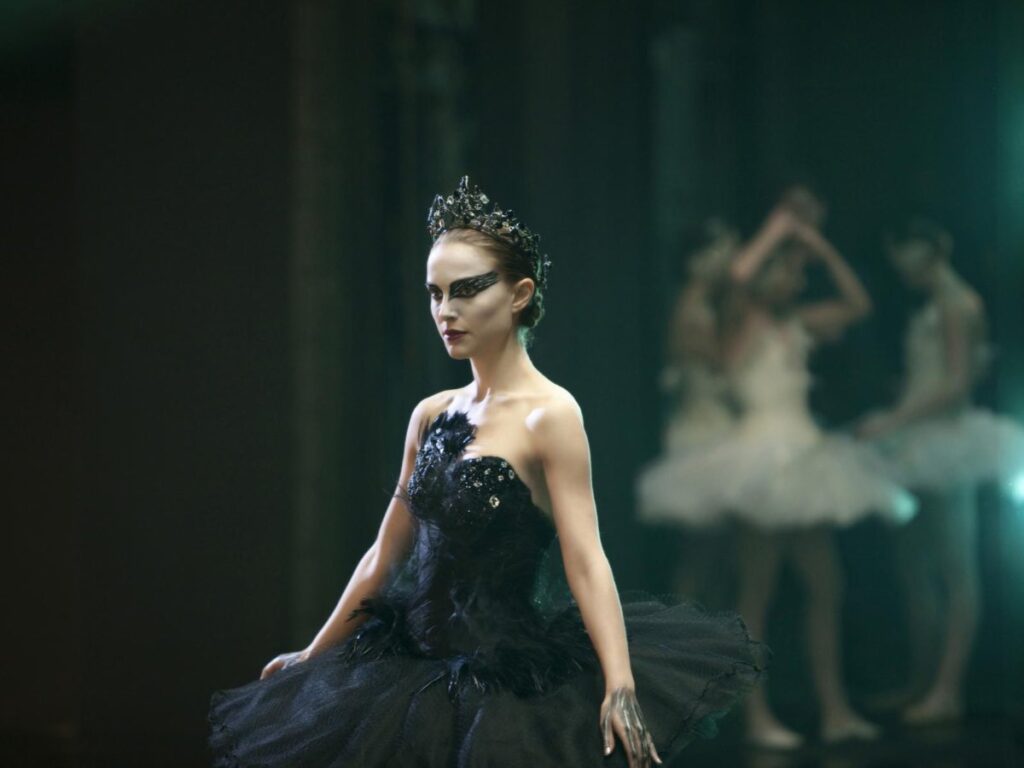Darren Aronofsky’s Black Swan is a beautiful tale of paranoia, obsessive chase for perfection and the dark world behind the blinding stage lights. The director’s fifth feature film, similar to his last project The Wrestler, is an exploration of what goes behind the highly competitive and physically demanding world of performance arts: professional ballet.
Aronofsky believes Black Swan to be a companion piece to his previous work The Wrestler. Comparing the two films, he says, “Wrestling some consider the lowest art — if they would even call it art — and ballet some people consider the highest art. But what was amazing to me was how similar the performers in both of these worlds are.” However, unlike The Wrestler, Aronofsky dives a little deeper with Black Swan and dissects our understanding of human fragility, mortality of an artist and the purest act of letting go. Aronofsky’s own passion for understanding the sacrifices and the mental state of an artist makes him a true postmodernist in a more real sense, who doesn’t differentiate between what many consider to be ‘low brow & high brow performance art’.
The film opens with Natalie Portman’s character Nina Sayers dancing with Swan Princess’ Rothbart. It’s a dream Nina wakes up to, a ‘crazy dream’ as she puts it, and with childlike pining, shares it with her mother. This crazy dream is, however, the only reality of a 28-year-old Nina who is a ballerina for the New York City ballet company. Nina lives alone with her overprotective and sometimes overly invasive mother played by Barbara Hershey, a failed ballerina herself and the only person she’s seen to interact with. But from their very first interaction, you know their relationship is anything but healthy.
Nina’s whole life looks like time spent in a narrow tunnel. All she’s ever obsessed about is dance, but the art form she has devoted her life to hasn’t paid off yet. She eagerly waits for Thomas to notice her and all she can do is to wait and be perfect when her name is called in. Her quest for achieving perfection is heartbreaking and the viewer cannot help but sympathize for this timid, fragile looking ballerina who loses her mind in pursuit of her art.
Classical Ballet is a notoriously private world, where underneath the pointed shoe, lie blood and bruises veiled to the outside world. It demands utmost devotion and rigorous perfectionism from its performers and inadvertently blurs the line between reality and perceived reality. This blur or rather conflict is eating away at Nina Sayers, Portman’s character.
Thomas Leroy, played by Vincent Cassel, is a ballet director at New York’s Lincoln Center, looking for a new face for his latest production of the ballet classic Swan Lake. From the get go, it is apparent that Nina is an ideal choice for playing the white swan but it is the role of black swan that Thomas is not so sure about. Her perfection serves very well when it comes to the virginal Swan queen, partly because she embodies the innocence and virtue of this character; it is much more like herself, pure and untouched but the Black Swan demands her to be open and free, something that can’t be taught.
The film slowly unfolds the internal struggle of Nina, who is quietly battling her own demons of identity and repression – a consequence of both the relationship she shares with her mother and and her obsession with achieving perfection in her art.
But when, to her and everyone’s surprise, she lands the role of the Swan Princess, her demons push her against everyone; she suspects that the world is conspiring against her and sometimes she is part of the conspiracy too. Thomas, who is psychologically and sexually abusive towards his dancers, launches Nina into a world of doubt and actively pushes her to break her boundaries. His active jeers and taunts break into her innocent psyche as she struggles between who she is and who she ought to be.
The tension and pressure Nina faces soon turn into a living reality, when she is met with Lily, a new dancer, who comes from the West Coast. Thomas pushes Nina’s wavering nerves by telling her to ‘watch her’ and she does. She watches her ever so clearly as a rival and sometimes as someone she aspires to be. Lily, who is not so perfect in her dance, is everything Nina is not. She dances for the joy of it, stumbles in her stance and laughs it off. Worst of all, she has Thomas’ attention.
Fyodor Dostoevsky’s The Double, a story about a guy who wakes up to find there’s someone who looks just like him and is trying to replace him, became one of the inspirations for Black Swan. Aronofsky explains how terrifying the concept of understudy — the fact that there is someone being trained to take your role if something were to go wrong — can be to reconcile with. Portman’s character is crippled with the same fear of being replaced, to be stripped off of everything that belongs to her, the loss of her very being. Lily embodies everything Nina fears, she is both distrustful and amused by her.
The film very articulately establishes early on that Nina lives a very sheltered, cocooned life, she hasn’t enjoyed the worldly pleasures for a girl her age. Her room is all shades of pink and filled with stuffed animals signifying her being stuck in time long passed. She wakes up reluctantly from her long reverie when Lily arrives. Her constant fear of being replaced by Lily feeds into her insecurities and she finds herself trying to seduce Thomas to prove that she is indeed worthy.
Prior to being cast in Darren Aronofsky’s ambitious drama, Portman often portrayed much younger roles. Portman once stated “I’m trying to find roles that demand more adulthood from me.” She embodies Nina’s character with exceptional honesty and colors her innocence, her struggle to find the woman in her with utmost sincerity, all the while declaring to the world that she, too, is a woman of her own. She manages to elicit sympathy for Nina and astound us with her spellbinding act.
On the surface, Black Swan seems like a traditional film about the obsessive artist; backstage rivalry, ever reaching self-doubt, insecurity and how the artist triumphed or succumbed to it all. But Aronofsky doesn’t make this a one dimensional act; his version is a unique, subversive retelling of Tchaikovsky’s Swan Lake. And Nina is no exception. Both Aronofsky and Portman are dauntless in their pursuits.
Nina’s perception of her identity is borrowed from her mother and she sees herself as a dancer first and a person second. In one of the scenes when Lily takes Nina out for drinks amidst the protest of her mother, she is introduced to a guy in a bar. He asks her, “Who are you?” and she answers in a heartbeat, “I am a dancer,” immediately realizing it’s her name he meant to ask. “Oh, it’s Nina,” she says.
Throughout the film, we see bruises and cuts on Nina‘s body. The film never explains where they came from. The recurring images of Rothbart combined with strange injuries Nina endures gives the film an eerie vibe, with some comparing the feel of the film with Polanski’s Rosemary’s Baby. But there are some giveaways to explain the phenomenon.
In one scene when Thomas is not pleased with Nina’s portrayal of a Black Swan, we suddenly see lights go off of the studio and in that fleeting moment of darkness, when the lights are back on, Nina is biting away her thumb nail. She hurts herself when no one is looking. Her drive for perfection mixed with her constant failure of assuming the role of Odile, the Black Swan, triggers her psychosis and we see her deteriorating mental state as the stakes grow higher each day.
Her hallucinations worsen as the film progresses and the only person who is aware of her condition is her mother, who too is equally responsible for it. Nina bears the burden of her mother’s expectations of being a golden child. And now it’s beyond her to let go of it.
Lily, who is depicted as a constant contrast to Nina’s character, is shown to be much more aware than her counterpart. But Nina is not as naïve as many think. She is aware that many believe she gained the role of the Swan Princess by seducing Thomas and part of her believes that too. To each giggle and stare she is tormented by self doubt whether she is indeed worthy. As she tries to take control of her own sexuality, she is subconsciously judging her actions.
She fears Beth’s destiny, who devoted her life to the dance company only to be discarded so easily. Her hallucination of visiting Beth in the hospital to return her things is her way of getting rid of any connection she might have with her. She is aware that something is happening to her and her visit to Beth was her attempt to make things right, to get rid of any wrongdoing she believes she may have done.
Throughout the film we see Nina’s attempt to find her identity as a woman but her quest of claiming her sexuality is not an act that came naturally to her like women her age. She explores and embraces her sexuality because her art form demanded it. Her art stunted her growth and it was her art that demanded Nina to be much more. Her psychosis that is triggered by constant strain is eating away at her and gives way to her darkness that Nina harbors deep within.
In one scene Nina notices strange scratches on her shoulder. On a closer look, she sees black feathers poking out of it. It is symbolic of Nina‘s very own demons. Nina sees Lily as the Black Swan who came to steal her destiny but she was looking at the wrong place and at the wrong person. She embodies both the white swan and the black swan; only the black swan is now taking centre stage.
Nina‘s metamorphosis into the Black Swan is complete on the opening night of ‘Swan Lake’ show. Her psychosis reaches a crescendo and she finds herself stabbing Lily with a shard of glass from the broken mirror in her dressing room. Her hallucination gets broken when Lily comes knocking on the door to congratulate her on her ‘breathtaking performance’.
She locks herself back into the room and sees a glass shard sticking out of her belly. The spell is broken, she realizes what she has done. As she takes the shard of glass out, she weeps silently for the loss of herself. As the final act approaches she sits before the mirror and blends her tears into her makeup. She realizes she has only one role left to play now, not Nina the person, but Nina the dancer. A Swan Princess.
For the audience, the Black Swan may well be a tragic tale about a sweet, innocent girl. It is anything but that for Nina. Her final moments are full of contentment and for the first time in her life she is at peace with herself. She has fulfilled her life’s purpose and achieved a feat which only few ballerinas have in their lifetime. She can finally lay with no regrets and no self hatred for the first time in what seems to be forever.
All self doubt and self loathing seem to vanish amidst the roar of the audience as Nina takes a dive. She loses herself in the moment and now that she embraced her dark side, she’s able to achieve something which she had struggled with all her life – transcendence. The screen then turns to white instead of the usual black, almost as if to give solace to the viewers that her final moments were of peace and satisfaction. As Thomas leans on her and repeatedly asks, “what have you done?” she answers, ‘she was perfect’ and as all things perfect she cannot exist in real life.




